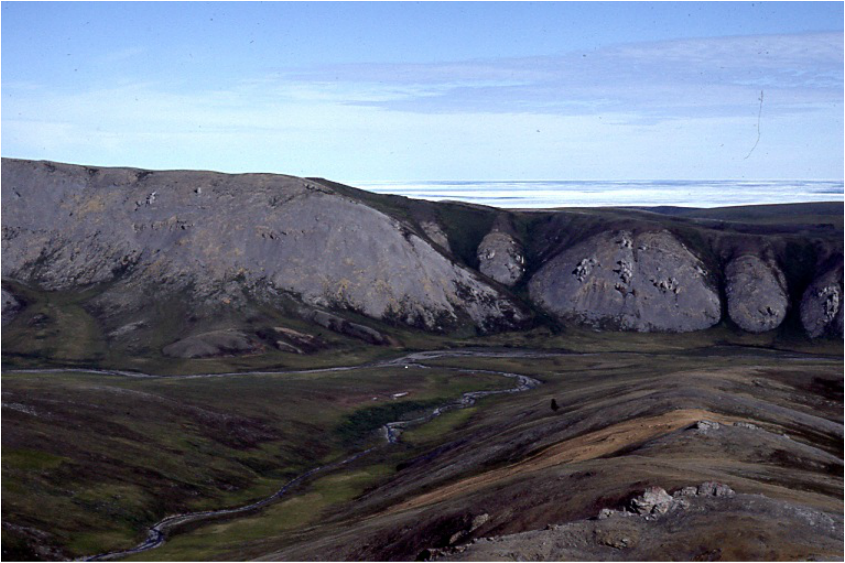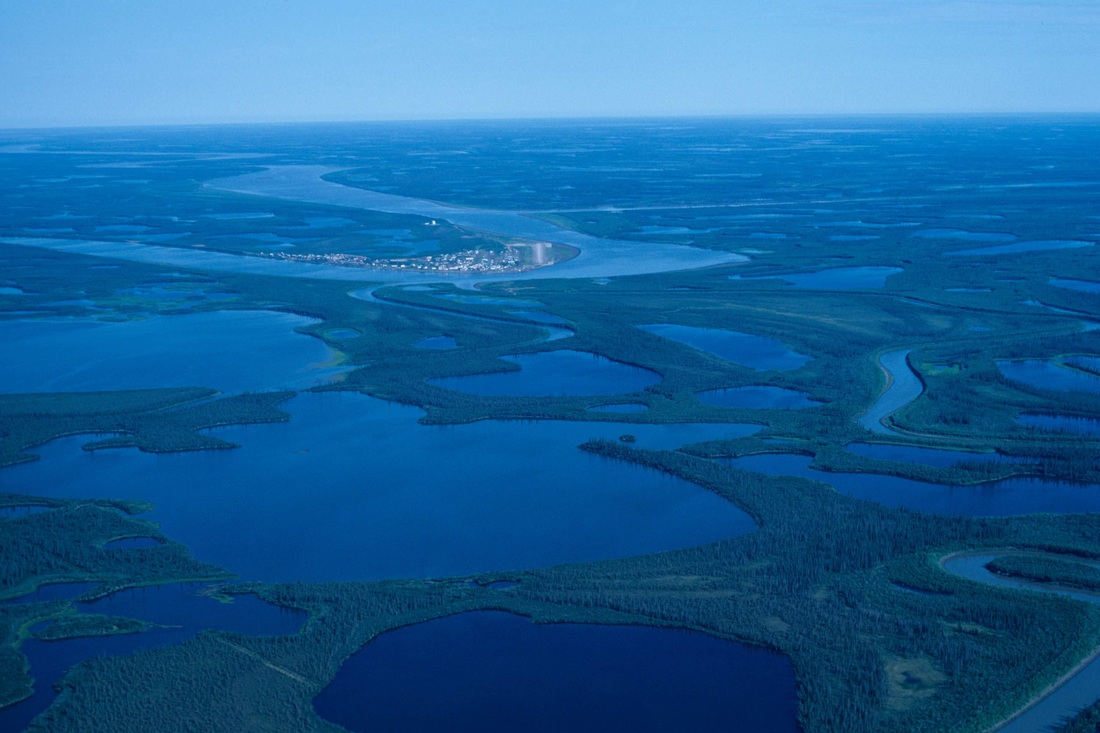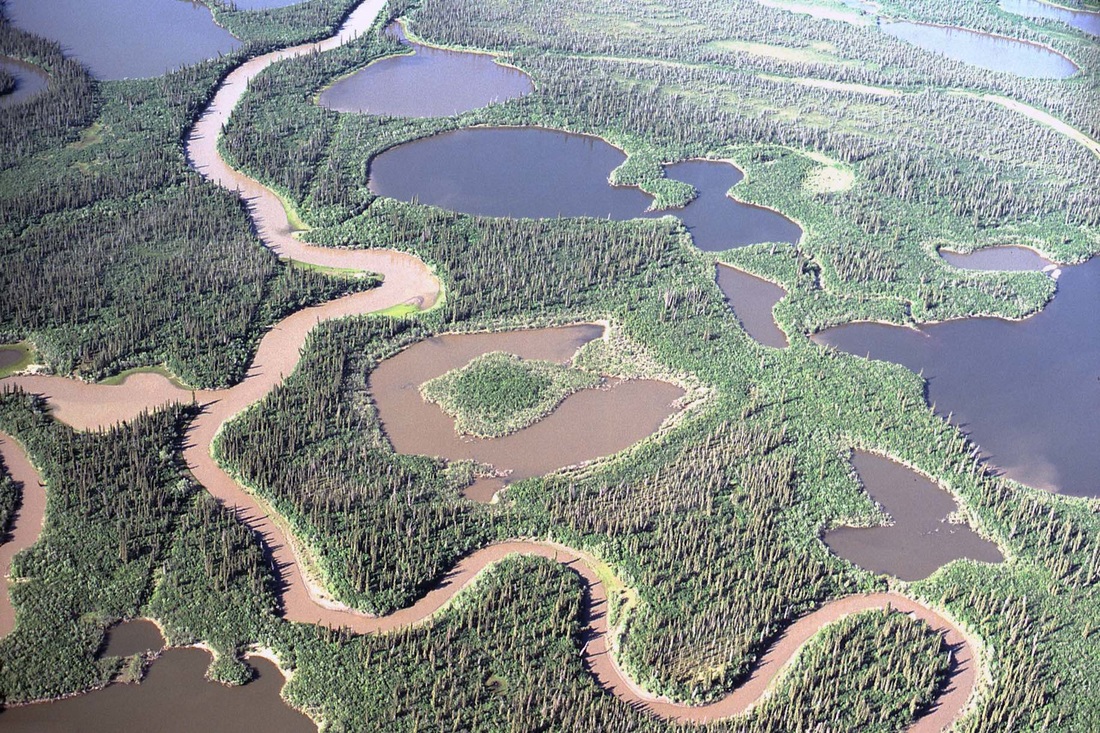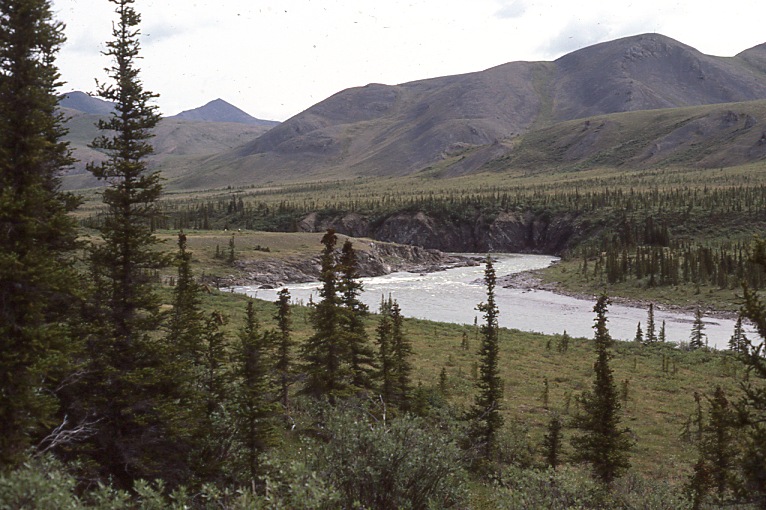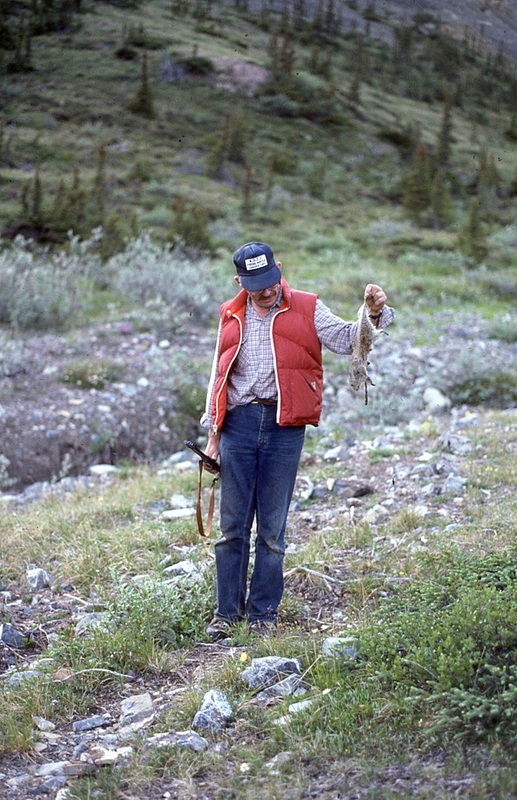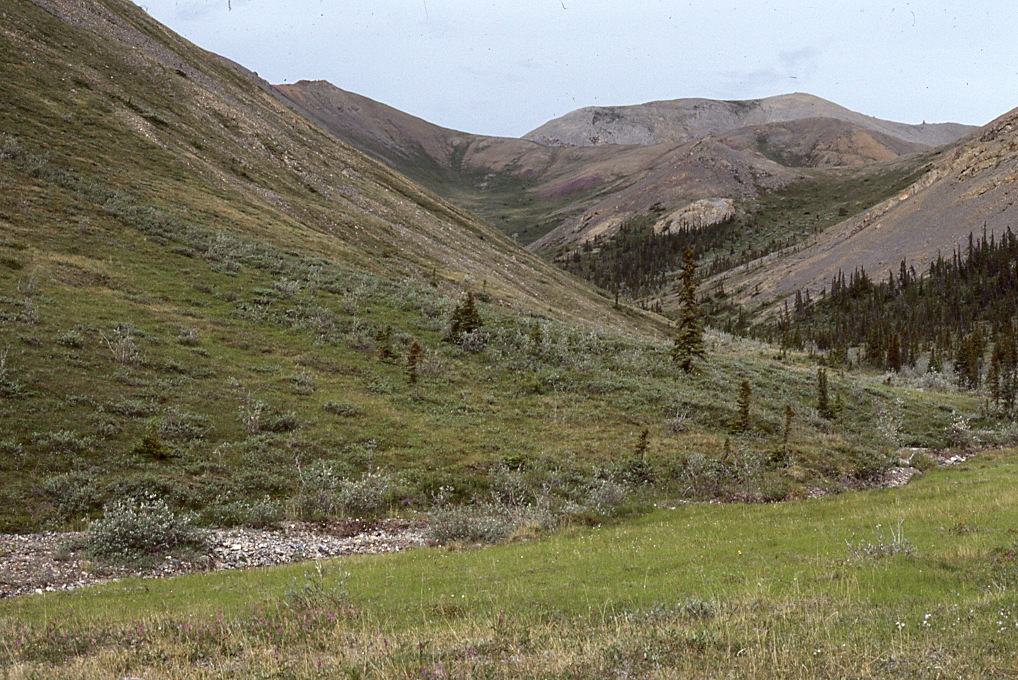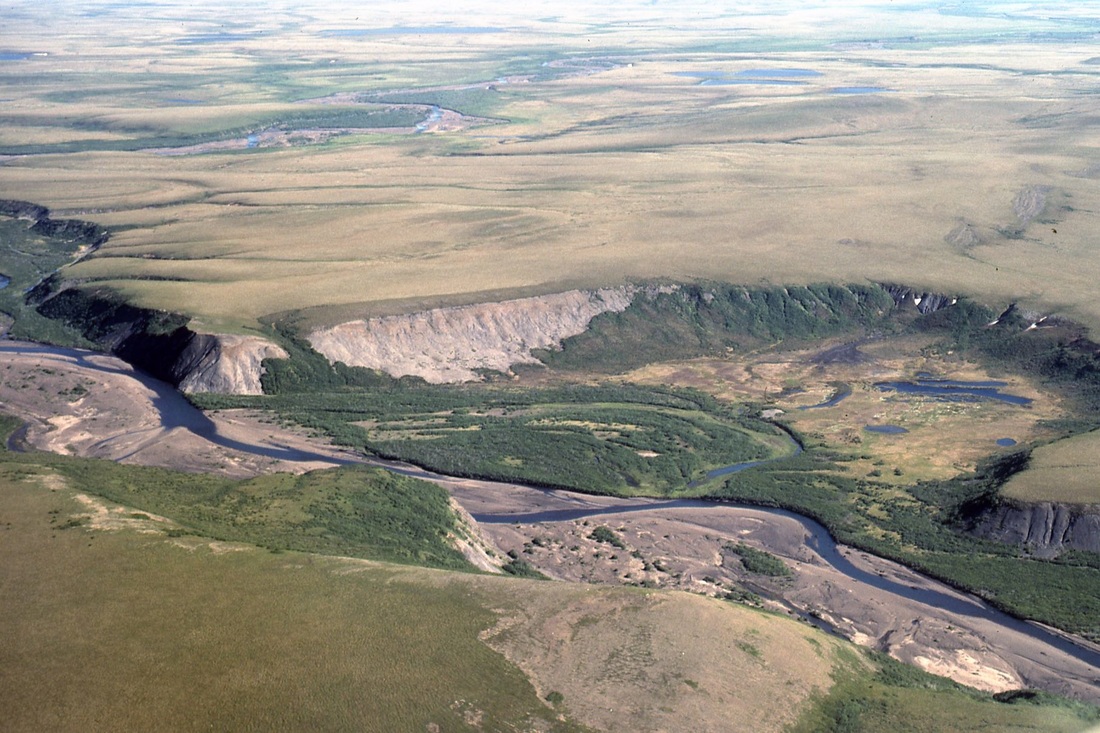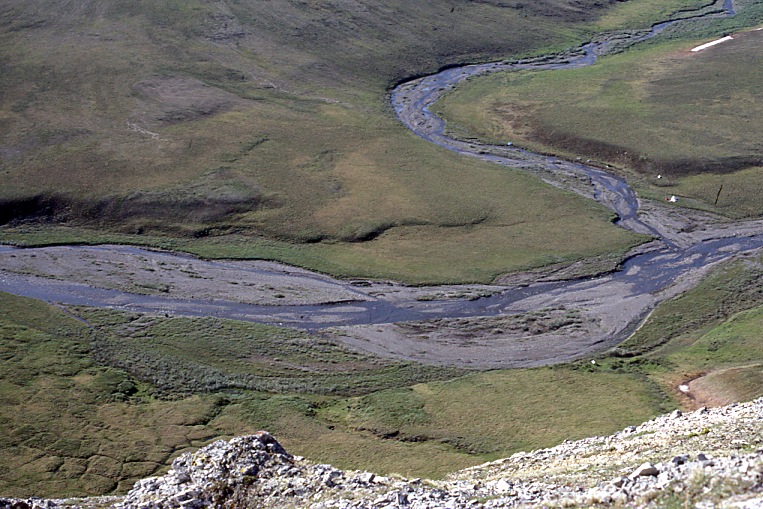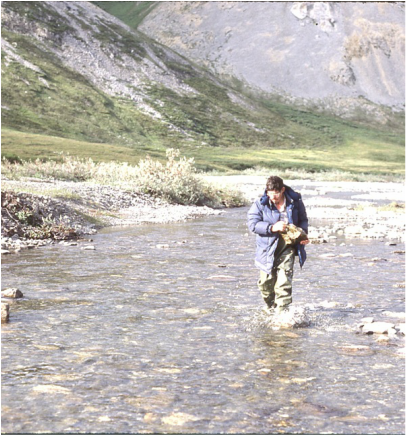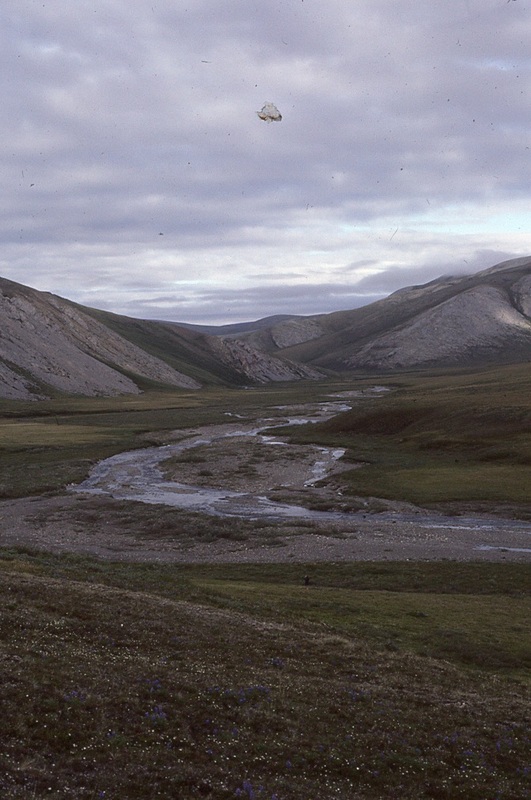|
|
19 June, 1984
June Creek, British Mountains, Yukon Dear Mum and Dad, I’m hoping the helicopter pilot will take this letter out with him when he comes to change our camp on June 23rd. So to tell you all, I’ll work backwards. Its 9.20PM and 4 of us are sitting at a table outside our tent in beautiful sunshine. I’m in my shorts and the 5 of us are after a super meal of packaged mushroom soup, spagetti with tomato sauce. Our arms, faces and the backs of our necks are tanned from 5 days of super weather. Our camp is up a small creek from the Firth River, about a mile from the River and a mile from the highest peak. There are thick clumps of spruce along the creek and up into the mountains, yet this is meant to be above treelike. We are 10 miles from the Arctic Ocean and I’m wandering around in 80F in my shorts! Today was a typical day, so let me describe it. I got up at 7.30 to wash my hair in water we had left in the sun yesterday, so the water was about 50F. I got our 2-burner stove going and responded to the twice daily phone-in on the radio at 8AM and 8PM from Polar Continental Shelf Project in Tuktoyaktuk. Our code name is Bug Camp. By 8.05, everyone is up for breakfast of coffee, toast and honey. The sun isn’t in our Valley as yet, so its usually 35F and we’re standing around in our parkas after forsaking our lovely warm sleeping bags. We are: Don Lafontaine, butterfly expert; Milt Campbell, beetle expert; Monty Wood, fly expert; Grace Wood, Monty’s wife and plant expert; and myself. Other than Grace, we all work at the Canadian National Collection. By 9AM we’ve usually decided on our plan for the day. I went down the creek to the Firth River. The vegetation changes from arid alpine tundra, to spruce-willow copses, to Glenamoy type tundra. At the River I can sit on a cliff about 40ft above the Firth which is raging below and watch small herds of caribou, usually about 50 at a time, pass on the opposite bank on their way to feeding grounds near the Ocean. Nearby a ground-squirrel is giving me hell for being so close to his burrow. I sampled all the way down and back. The most interesting was a pile of grizzly shit - a blueberry meal from last Autumn. It had obviously passed very quickly through the bears digestive system because the blueberries still burst in my hands when I was collecting the pile. There’s an old hunter’s cabin in a clump of large spruce trees, long since fallen apart, with his food cache nearby - a treehouse on 10ft stilts to keep the bears away. The wooden stilts are put into stove pipes so that wolverines couldn’t climb up. The cache was also falling apart - long since abandoned.We had supper around 7PM and at 8PM have the radio call-in. Then we sit and work on writing up notes, the people who have to pin insects, pinning them, and usually have hot chocolate around 10.30 before wandering off to our tents. Don continues looking for moths until 12.30 but by that time most of us are fast asleep. Its an idyllic existence - no responsibilities except trying to collect as well as we can. I left Edmonton on the 14th, having spent the day with Indra. Don and Milt were at the airport and were delighted to see me as they had a long wait. The flight to Inuvik was uneventful, with stops at Yellowknife and Norman Wells. Monty and Grace were waiting for us at Inuvik airport at 11.15PM plus someone from the Research Station in Inuvik who brought us to the Labs and gave us the key to the trailers at the back where we could sleep. The cook from Polar Continental Shelf Project was also staying in one of the trailers and told us where to go for breakfast etc. Each trailer has 3 bedrooms, kitchen, living room and bathroom, so is quite palatial. We were all up by 7.30 and went to the recommended local for breakfast - the Eskimo Inn. Inuvik has 3000 permanent residents and has an all-year gravel road going to it, plus 2 flights a day, plus its a major set-off point for oil rigs, so its a bustling ugly town. Back at the Lab we organized our flight to our camp site that day and then went grocery shopping. At 1.30 Don and I left by helicopter for Sheep Creek an old, small grass landing strip on a side creek of the Firth River. There’s an Inuvik family that sluices for gold there every summer. We had heard about them and the landing strip is famous for having 2 airplane wrecks at opposite ends! The helicopter was a 3 passenger job. The pilot, Colin, a really nice fellow from British Columbia, working in the Arctic for the last 4 summers, with this his first in the western Canadian Arctic. Don and I went ahead to pick a site for our next camp after this one. We flew at about 1000ft over the Mackenzie Delta and it was extraordinary - just a vast area of muskeg, willow and some tall spruce in patches. You could distinguish the river branches that led nowhere to those that were flowing to the sea by the muddy water in the latter. There were some fishing cabins of Inuit and Indians below, but very few. It took about an hour to fly over the Delta and then we were over the North Slope, i.e., the area about 10 miles wide between the mountains and the Arctic Ocean. The Ocean was iced up almost to the shoreline and we could see caribou feeding on the North Slope. Another hour and we arrived at Komakuk Beach Dew-line site. This is an Early Warning site manned by Canadians, in Canada, but supplied and paid for by the USA! It has an an interesting history, being built by the Americans under the assumption they were in Alaska; in fact they were 12 miles into Canada. Polar Shelf has a refuelling depot there. They invited us in for coffee and brownies - these places always have super cooks - which was most welcome as it was freezing at the coast. Also, that Dew-Line site has a reputation of being unfriendly to visitors - they certainly were kind to the three of us! The following is 2016 information on Komakuk from Wikipedia “Komakuk Beach was the site of a DEW Line station, located on the Arctic coast of Yukon, Canada. The station was closed in 1993 pursuant to the general policy of dismantling such stations that was adopted following the collapse of the Soviet Union, which effectively ended the Cold War and obviated the need to maintain these installations. Komakuk Beach had been the scene of considerable environmental damage, which took seven years to clean up; following this, the site was incorporated into Ivvavik National Park in 2000.The immediate area surrounding the former station is completely uninhabited, as the northernmost settlement within Yukon is at Old Crow, approximately 225 km (140 mi) miles to the south.Situated in a narrow coastal plain at the base of the Richardson Mountains and having a tundra climate, Komakuk Beach is located at 69°35' North latitude and 140°11' West longitude.” Then on to Sheep Creek, checking for sites the whole time. We arrived at the same time as the Twin Otter bringing the others, plus equipment and supplies for 3 weeks. The people mining gold at Sheep Creek came up to check us out and to stand around and talk for awhile - they have quite a bit of equipment there, but we didn’t really get a chance to look around cause the airstrip is about 30 ft above the river and we were filling the helicopter to bring our gear into the first Camp. This, which we named ‘June Creek’, is an idyllic spot, as I said before, on a creek fork, so we need to go no more than 20ft for ice-cold water. There are loads of trees - spruce, willow, juniper around, for going into the bushes for a pee and enough flat ground for putting up tents. We each have a small 2-man tent for ourselves plus there are 2 larger Logan tents for working in when the weather is lousy or cold. We finally got camp set up and had our first meal going about 10PM: oxtail soup, beef cut up with onions in a sauce, rice and salad. Colin was staying with us until the weekend, so he took over one of the Logan tents. We all slept like logs. On Saturday, Milt and I got a helicopter ride to a lake south of here, close to the Firth, and the other three went to a mountain top. We had a super day collecting in the bright sunlight up the lake and river and the helicopter came to take us back about 4PM. Sunday, Colin brought us all to a high peak a 3hr walk away and he took off back to Tuktoyaktuk. We collected around the peak for hours and walked back to camp - hard going for me, as I had vast quantities of soil with me and was laden down. Funny arriving back to the camp and not seeing the helicopter there. I had pitched my tent in a position where everyone thought it would be whipped up when the helicopter took off. In fact, it was one of the other fellow’s tent that was flattened - not too much damage though. Monday, I went up our valley to the high peaks around - beautiful area with views of Dall mountain sheep climbing scree slopes and generally having a great time by myself. We have had gorgeous weather so far - at least to mid-70’s every day - fantastic. June 20, 1984 The weather changed this evening, it was windy, cold and sunny all day. I walked to the highest ridge around here - you can see the Arctic ocean in one view and spruce woods in another and arid peaks, small amounts of snow in N-facing clefts and the Firth River valley laid out below. This area gets very little precipitation so most of the creeks are already dry. In fact, with the sun the clayey slopes are dusty when you walk over them. Most of the scree slopes look barren, but when you look closely they have tiny beautiful flowers, including lupins, scattered around. They put their roots down very deep and when I dug down there is rich soil below. About 5.30 the rain started and kept on more or less continually through the night. My sleeping pad acted like a sponge, so my sleeping bag got wet - ugh! June 22, 1984 Well we’re sitting around waiting for the helicopter to arrive. Monty and Don have gone to a nearby peak and the idea is that the helicopter will bring in Syd Cannings, the 6th member of our party from the University of British Columbia, pick up Grace, Don and Monty and deposit them on another peak, and then take Milt and I to the coast to sample gravel bars. Then we’ll all decamp to a new camp site tomorrow. We radioed to Syd to pick up some food in Inuvik, so I think that is why the helicopter is delayed. Well the night of June 20th it poured. We had a smashing supper cooked under a tarp and then eaten in the Logan with the 5 of us kind of squashed on 5 camp chairs around the table, but we were all cheerful. We woke to thick, dank fog, but it cleared eventually to a beautiful day around 11AM, so I got my sleeping bag and tent dried and had a super day collecting. Then later we celebrated the longest day of the year around the fire we burn every second night for garbage to discourage bears. We had liqueurs which I and Milt had brought with us for such occasions. We had a visit from a porcupine the night of the rain. Don had laid out his spreading trays for moths on the floor of the Logan and found the trays gnawed in the morning. He suspected a vole, but later in the day we found the box with biscuits chewed (luckily not the biscuits) and a porcupine quill. And last night when I went to my tent I surprised a ground squirrel who may have been checking it out for winter habitation - I think I was as surprised as it was. Syd arrived later; he is Curator of Entomology at the the University of British Columbia. I know his brother, Rob, from the Biological Survey of Canada. Monty, Milt, Syd and I went looking for a new camp site. Only Milt really wanted to move camp, the rest of us felt that the area had still lots to offer for collecting. We looked up a good few valleys, but couldn’t find quite as suitable an area, i.e., adjacent to peaks made of different types of rocks and flat boggy areas. so we decided to stay put, as Colin and his mechanic were staying at Komakuk Beach Dew-line site and would come in on the 23rd to ferry us around. I left my pack outside my tent while making supper and returned to find the back of it chewed by my friendly ground squirrel. The others, with much more experience with the persistence of ground squirrels once they have found a source of winter packing, decided that it would have to be killed. Milt, who is a good shot scared him away when the squirrel arrived at my tent for more backpack. I thought that would give him the message, but within an hour it was back and Milt shot him cleanly. I felt awful, but realized that he would just start biting holes in my tent. June 23, 1984 Colin took Milt, Syd and I to Sheep Creek, up from the gold-mining operation. Milt was looking for beetles under stones close to water and we were general collecting. In the meantime the others were across the Firth River on a mountain top. Later, Colin moved us to a small pond, we called ‘Swan Pond’ because the first time we saw it there were swans on it, and we continued collecting. About 3.30 though the rains started and it poured - I had enough clothes to be warm, but got soaked waiting for the helicopter. We had hot chocolate when we got back and a change of clothes, and a super meal in the Logan until the rain moved off later in the evening. June 24, 1984 Just a fabulous morning. Most mornings we had quite thick dew, but this morning was perfect. We decided to repeat last Sunday’s experience, i.e., Colin to ferry us to the top of a mountain a distance from camp and to walk back. We chose the same mountain as the last time, which we christened ‘Sunday mountain’. I sent out 5 boxes of soil samples back to Agriculture Canada, and had sent 2 boxes the previous weekend. Somehow the word had got around about the shipments, cause when Syd overnighted in Inuvik he was asked by Debbie the camp cook at Tuktoyaktuk was he going to the camp “that was sending out plastic bags of insects”! We had a super day collecting. I climbed the highest mountain in our immediate area and found a centipede on top - very unusual in what is meant to be the arctic. June 25, 1984 Today I went collecting down by the river and walked along the old delta of our creek. It was amazingly hot, and I wished I was in shorts. I even found a wild chive plant which was really tasty, but most I brought back to Grace for pressing for her Botanical collection. The morning of the 26th we woke to a day of heavy rain and no hope of lift. Monty , Don, milt and I usually wake just in time to get the 8AM radio call in. but this morning, only Don and myself were up. We decided the only way to survive the rain was to set up our lean-to, i.e., tarp over the table and stove underneath and make pancakes; that got everyone up. Later we all sat in the Logan and worked and read. I started and finished Eco’s ‘The Name of the rose’. We made popcorn and brewed various hot soups and teas to keep us warm. It was still raining and bitterly cold when we went to bed - me with all my clothes on! June 27, 1984 Woke to snow falling on my tent and snow on the higher peaks - definitely a pancake morning. This time everyone got up and by the time we had finished breakfast and taken photos of the high peaks and our rather tinker-type cooking facilities, the rain had stopped. It turned into a super day and we went sampling to a high alpine valley. 28th was another day of rain, with the six of us in a small tent. Luckily we get along splendidly and generally end up bursting out laughing at our situation. We played cards, read, made popcorn - anything to pass the time. It was a dour cold, Irish winter day, all day, but the cheer in the tent was just great. We had a super supper of salad and chicken, with hot chicken sauce on mashed potato. Luckily we have hit on a superb salad mix that does not need refrigeration - red cabbage, onions, carrots and alfalfa sprouts and will be able to have salad every second day to the end of our trip. That evening we heard on the radio that we will be moving tomorrow - I hope it clears up so that we can pack camp in dry conditions. June 29, 1984 A nice, cold, windy but dry day, so we were all packed by 9.30. By 12.15, and no sign of the helicopter, we were sitting around fidgety and bored. I went off collecting along the East Ridge of our Valley - one I hadn’t been on before. I found an area where sheep shelter and sit and continued to the end of the ridge collecting. At the end I had a super view of the Delta of our creek and the Firth River. I heard the helicopter arrive, so had to return at quite a clip, but as I was walking on scree slopes, the rock type changing every 30m, it took me some time. Arrived back to find they had started supper before the helicopter arrived, so I was in time for that. Colin, and his mechanic, Nigel (from Coventry, UK) were waiting for us to finish, to start moving us to our Fish Creek Camp, which is about 10 miles from the Arctic Ocean and in complete arctic, with no real trees, except willow shrubs along the river banks and low-lying birch. Milt, Monty and Grace went first to pick a camp site and then Colin returned to take the baggage in a sling. That took 2 trips and was fascinating. He takes the door off the helicopter to reduce weight. We pack stuff into the sling and then they tie a strap onto the bottom of the helicopter. the helicopter hovers over the sling, they attach the other strap and then Colin slowly takes off - quite a sight. While Colin was going back and forth we were dragging conversation out of Nigel. He was British Navy for 5 years and now working with Quasar Helicopters who have the contract to fly us and other government types for 3 years, out of British Columbia. He’s still “just out of Coventry” though. He goes on 6-week stints with a helicopter and pilot. This is both his and Collin’s first time in the western Canadian Arctic and they are not impressed with the ‘disorganisation’ in Polar Shelf - the government body that contracts Quasar. About 2 hours later Don, Syd and I finally flew in to our new camp and just got out tents up before the heavens opened. Monty, Grace and Milt had just got the first Logan tent up so we had somewhere to sit for our after supper coffee. We’re all tented along the same strip of land by Fish Creek, with enough space between tents so that we are fairly private. There are loads and loads of caribou in this area, so much caribou shit to kick out of the way before we set up tents. We finally got to bed at 10.30 - quite exhausted after the waiting and moving. 3 July, 1984 I’m sitting on a mountaintop in the lee of the wind with a view of the North Slope of Alaska, the Arctic Ocean, and the easternmost ridge of the British Mountains. To recap: well the morning of June 30th was very foggy and damp. Most of us had slept fitfully from the cold and damp and the ground that hadn’t been broken in and unfamiliar sounds in the night. We had got used to our June Creek Camp and thought of it as ‘home’,. Nothing like breakfast though to improve our cheer. Monty decided that Don, Syd and I should learn how to put up a Logan tent for future needs. It is a double-walled tent, and I’ll describe it here, so that I remember. The outer tent should be staked down roughly. The inner tent is turned inside-out to expose the back ropes which are tied to the outer frame by crawling in underneath the outer tent and starting tying in the middle of the back and working in both directions. There are 2 series of ties - one on the floor and one partially up the tent. Then secure the outside ropes and secure inner tent to outer tent in front. Then erect centre pole and put into tent to erect the tent. Secure the front rope and finish minor adjustments - sounds easy! How they did this on Mount Logan is beyond comprehension. The day continued slightly foggy and with a low ceiling so I went collecting along fish Creek where I couldn’t get lost. I found poplar and juniper bushes and centipedes - hard to believe this far north. On my way back I saw a plane buzzing the camp and then later saw some people from the camp coming towards me - when they saw me they turned back to camp. Two things had happened while I was away. the plane turned out to be Alaska Fish and Wildlife Service and they dropped a note saying they were studying the Porcupine Caribou Herd and that there were 10,000 caribou to the south of us. We had been seeing large (200 animals) herds of caribou in the hills close to camp all day. the 10,000 caribou were part of the 150,000 caribou migrating to the North Slope east of the Firth River to feed. The note was really friendly gesture as they were flying over. The second thing was that Monty had been going to the toilet behind some bushes and had looked around to see a grizzly heading towards camp. He sounded the alarm - 3 blasts on a whistle (we all had one). the bear stopped about 50m from camp and then ambled off - we had been expecting some in the area because of the caribou. They had come out to check where I was relative to the bear, but I was miles away from it. We had a super supper, the clouds started to clear, so we all got hopeful for better weather. July 1,1984 Just a perfect day for the arctic - cloudless and windy. most of us climbed the ridge north of the camp which gives a super view of the Arctic ocean and the surrounding mountains. We had a super day collecting and came back to make a special July 1 (Canada Day and a holiday) supper. We toasted the day with Irish whiskey which Syd had brought along, and as it was a warm dry night we all slept like logs. I had got up early the morning of July 1 to wash myself and a herd of caribou had walked right by camp while I was in the process. Another herd came through after breakfast - quite a sight. July 2 was another beautiful morning. I started up the ridge early and was just at the top when a helicopter arrived in camp. These were from the Canadian Wildlife Service studying the impact of bot-flies on caribou. As Monty is the fly expert they were calling on him asking his advice on collection techniques. They were not impressed by Polar Shelf’s vagueness as to where we were; they said we were “somewhere along Fish Creek””, but said it would be impossible to miss the “small town we had set up”! They left behind peaches as a present, and took Don and Syd to the ridges opposite the camp and Monty and Grace to a nearby hill. I walked almost to the aufeis, i.e., a permanent patch of ice because of the presence of a spring. When I returned to camp, I went sweeping insects and then heard blasts on the whistle. Rushed to camp to find that Syd had seen a grizzly about 1/2 mile away heading towards camp with Milt between the grizzly and the camp. It turned out that Milt had seen the grizzly and was trying to get back to camp to warn us. The bear didn’t see Milt but was wandering towards him . Milt was trying to get his flare out or do anything to make the bear aware of his presence. We were watching all of this through binoculars and saw the bear rear up on hits hind legs about 30m from Milt. When the bear finally realized that Milt was there it ambled off in the opposite direction - much to everyone’s relief. Well that should make a great story in the retelling. July 3, 1984 Another glorious morning. I had a terrific day sampling and walking the hills. Returned to camp to find that Milt had another encounter with a grizzly, who had charged him until it realized that he also was large animal. Milt shot off some flares and the grizzly ran away. Had a lovely, uneventful day after that. July 4 was also beautiful - the helicopter was coming in the evening to bring Milt, Syd and I back to June Creek to remove traps and me to collect. During the day we had a visit from another helicopter and a fly-over from an Alaskan plane - this place is definitely on the main route to somewhere. The helicopter came just as we were starting supper at 6PM. We went and got our samples and traps and had a late supper at 8.30. Then another bear came towards camp. This one was remarkably nosy and we had to fire the rifle and a few flares to discourage it. This was our first calm evening and the mosquitoes were out in droves, plus for the first time it was really warm here. We started tidying up because we are going back to Inuvik tomorrow. It is amazing how fast this collecting trip went, and we’re sad to leave - there is really no place more calming than the arctic in summer. July 5, 1984 Colin said that he would be in to move us at 9AM, but it is 11AM and still no sigh of him. The plane is coming in to pick us up at Komakuk Beach this evening but in the meantime we want to collect at Clarence Lagoon due west of here on the coast. We had a visit from another grizzly this morning. Colin arrived much later to take us to Komakuk, just as I was half way up a mountain collecting - he waited for my return. His delay was due to the cold weather - every time he started to leave, the helicopter would ice up in the cold fog. We parked our pile of belongings at the edge of the runway at Komakuk and took off for Clarence Lagoon - a large area of tussock tundra and polygons by a very large area of water, cut off from the ocean by a gravel bar. It was not quite what we expected, but we sampled for a few hours - the mosquitoes were horrendous, so we were really glad of our bug jackets. We were sitting on the runway waiting for our plane at 8PM. Monty and I went into the station to phone Ken Borak Airlines to check on their arrival time to pick us up and to ask for water, as we were cooking our supper on oil drums at the end of the runway. Monty had heard that the cook went fishing for arctic char every evening and asked if he could go along to try his hand. We had hoped to get invited in for coffee and brownies, but obviously policies had changed! But the cook said he would bring us fishing - so things were looking up. Just as we were having coffee after supper the cook and 2 other fellows arrived and we all took off for the mouth of Fish Creek, where the char were running. What fishing! Within an hour Milt and Monty, with just one rod, had caught 7, 4lb char, the cook had caught about 10 and the others, Inuit, had caught about 20. They were catching them for us too. The manager came out about 45 minutes before the plane arrived to give us time to clean the fish and drive us back. We only took the 7 largest fish, but the kindness of them - they laid on plastic bags and cloths for us to wipe our hands. It turned out that the Manager had his home in the same part of Ottawa as Milt and their children went to the same school. so I think if we had camped that night in Komakuk we would have been invited in for breakfast the next morning. We had an uneventful trip back to Inuvik in the Beechcraft which only took 50 minutes, rather than the 2 hours in the helicopter. Moe McCrae and a showered and cleaned Syd (who had returned with Colin in the helicopter) were waiting for us at the airport to drive us to the trailer at the station where we were spending the night. We dumped our luggage and took off for the Mad Trapper, which is THE PUB in Inuvik. It’s a total dive, with loud, though really good rock music - one of those unique places where the world meets. Its the Grand Central Station of the western Canadian Arctic - locals, army, scientists, drillers, pilots, executives, everyone drops in when they come to Inuvik - se we all got pleasantly jarred on beer and had that great feeling of camaraderie that a trip like this engenders. Around midnight, Don Oliver arrived in, another CNC entomologist, who would be spending 2 weeks travelling and collecting with Syd. On the 10th Don and Syd were taking off with Colin to Summit Lake, south of Inuvik. The rest of us had the day to pack up our stuff to be shipped back to the CNC and to wander around Inuvik, and to thank the people at the Lab. for all their help -what a superb field trip. |
